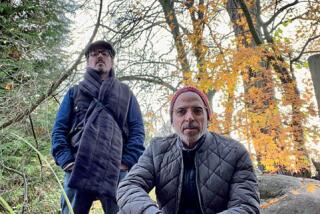Owner Tunes Up Ailing Brazilian Firm Into Harmonica Success Story
- Share via
BLUMENAU, Brazil — The door of the old timbered warehouse swings open to the squawking riff of a mouth organ being tuned and Alberto Bertolazzi, a hero among harmonica players, strides into the factory he has saved.
Inside, Bertolazzi gets a warm welcome from his 80-strong staff, and for good reason: with quick thinking and bold moves, he has transformed Fabrica de Harmonicas Catarinense, an ailing musical toy maker battered by globalization, into a fast-growing, innovative manufacturer of harmonicas.
It’s just a niche. But only four competitors vie for an estimated world market of $130 million. And unlike other “period” products such as juke boxes or pinball machines relegated to retro obscurity, demand for the harp is growing. In Brazil, there’s a boom in cowboy-style Sertanejo music, abroad a renaissance of blues, country and psychedelic 1960s music.
“You could say we’ve been saved by the Age of Aquarius,” Bertolazzi grins.
Instead of the firm going under, as cheap Chinese imports swamped Brazil, the jovial, 58-year-old stockbroker-turned-musical impresario used globalization to his advantage.
Rethinking Hering, as the company is known, he expanded distribution overseas, tailored harmonicas to specific consumer markets and breathed a bit of high-tech air into the time-honored business of making mouth organs.
“Hering has a good product,” said Brian Majeski, editor of New Jersey-based Music Trades, an industry magazine. “They’re quite new to the U.S. market but they seem to be making good headway.”
Just half a decade ago, the factory was on the brink of bankruptcy because of an outdated and unloved range of accordions, toy pianos and clarinets--the legacy of Alfred Hering, who founded the company 80 years ago when a wave of German immigrants built this most Teutonic of Brazilian cities, 300 miles southeast of Sao Paulo.
After opening its borders to international trade in 1994, Brazil saw several traditionally strong industries, particularly labor-intensive ones, swamped by a deluge of cheap products, mainly from Asia. One of the first casualties were toy makers.
Entrepreneur Turns the Company Around
Giant toy maker Trol went bust and rival Estrela took a battering: its pre-1994 work force of 12,500 has shrunk to 300. Once, Brazil’s association of toy manufacturers had more than 500 members. Today there are 60.
Into this adversity stepped the Milanese-born Bertolazzi, who admits to being a ham-fisted amateur on the harp. Armed with an American MBA, Bertolazzi came to Brazil and set up the country’s first auto leasing company in 1970. Eight years later he sold out at a healthy profit and founded a stock brokerage.
One of his investments was Hering, whose shares were languishing. Bertolazzi bet the drop was temporary and bought 80% of the company in 1990 for a bargain basement price that he declined to talk about.
Changing the Firm’s Focus Was Essential
It was clear Hering would not survive. Bertolazzi had a choice: lose a lot of money or rethink the company. He negotiated to keep the brand, some of the machinery and 25 specialists in harmonica production, part of the original work force.
The new plan? “Stop producing loss-making toys and focus on something we were competitive in.”
Today Hering vies with Germany’s Hohner, and Suzuki and Tomba of Japan for about half of the world’s harmonica market. The other half are Chinese-made toy harmonicas and those made for music instruction.
Hering is still behind, selling $2.2 million worth of mouth organs and musical accessories last year, slightly higher than 1999. But Bertolazzi predicts 50% sales growth this year.
Already dominant in Latin America, Hering recently signed a contract with Yamaha, under which the world’s biggest instrument maker will initially distribute $1 million worth of Hering harmonicas in Japan.
Hering is also marketing “the only true all-American harp” in the United States through a new Miami office.
Japan, where annual harmonica sales reach $10 million, and the huge U.S. instrument market worth $7.5 billion, are now Bertolazzi’s two main targets.
In the United States, the Brazilian spotted a trend of retail consolidation. Specialty stores are being gobbled up by multibrand mega-stores that buy directly from manufacturers. Bertolazzi is negotiating an exclusive deal with fast-growing Mars Music, a chain of superstores.
On Hering’s factory floor, little has changed for decades: holes are punched in carefully aged steel plates, brass reeds are fitted and chrome housings polished by hand. Finished instruments are tuned on archaic, foot-pumped machines.
“We are the only ones in the world who tune our harmonicas three times before packaging,” Bertolazzi boasts.
But exporting has meant changes. “In the States, people said Hering harmonicas were great but looked cheap, so we upgraded the plates from brass to bronze,” says Bertolazzi. “For Yamaha, we had to add three dots marking the octaves. Don’t ask why. The Japanese prefer them that way.”
All cosmetic stuff. But Bertolazzi also insists on innovation, taking Hering’s first high-tech harmonica to a Los Angeles music industry fair this year.
Developed by British musician Richard Smith, the new Hering Electric Harp has a funky lime green plastic casing and a wire hooking up to an amplifier, meaning no extra microphone is needed.
“Finally people will be able to see what the guy on stage is playing,” Bertolazzi says.
The new harp, played by blues maestro Peter “Madcat” Ruth, got a chilly reception at last year’s annual meeting of the U.S. Society for the Preservation and Advancement of the Harmonica, in Detroit.
But there, the average age was 70.
“The harmonica is an instrument that needs to attract younger people--that’s what we’re trying to do,” Bertolazzi says. “If it doesn’t, it might go the same way as the juke box or the pinball machine.”
*
On the Net:
Hering company site:https://www.heringharp.com
More to Read
Sign up for Essential California
The most important California stories and recommendations in your inbox every morning.
You may occasionally receive promotional content from the Los Angeles Times.













